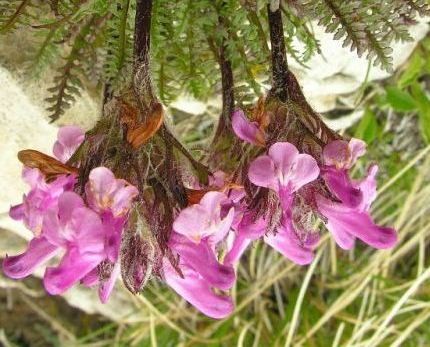Thin pedicular
(Pedicularis orthantha)

Description
The thin pedicular (scientific name Pedicularis rosea Wulfen, 1781) is a parasitic plant belonging to the Orobanchaceae family. These plants are 2 to 15cm tall. The biological form is hemicryptophyte rosulata (H ros), i.e. in general they are herbaceous plants, with a perennial biological cycle, with wintering buds at ground level and protected by litter or snow and have leaves arranged to form a basal rosette. They are also parasitic plants: the roots show specific organs to feed on the sap of other plants. The roots, large and fleshy (taproot), are distributed radially trying to reach the roots of other plants to suck their sap. The aerial part of the stem is erect or ascending; the lower part is hairless, the upper one is lashed and reddened. The leaves have a pinnatosette (or pinnatofida) shape with an oblanceolate -spatulate outline; the segments are strictly lanceolate and generally acute. Size of the leaves: width 1 cm; length 5 - 8 cm (maximum 12 cm). The inflorescences are formed by dense and short spikes of the capituliform type (globular grouping of flowers). At the base of each flower there are bracts with a leafy appearance (similar to the upper leaves). The flowers are hermaphrodites, zygomorphs (of the bilabiate type), tetramers, that is, with four verticils (chalice - corolla - androecium - gynoecium) and pentamers (the corolla and the chalice have 5 parts). Flower length: 12 - 18 mm. The fruit is an ovoid or ovoid-lanceolate bivalve loculicidal capsule. The seeds are few and angular in shape.
Taxonomic tree:







